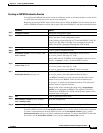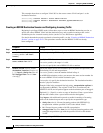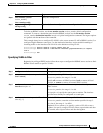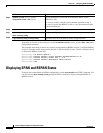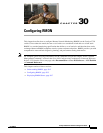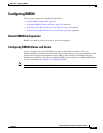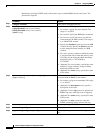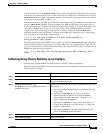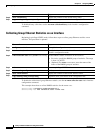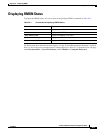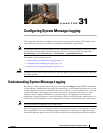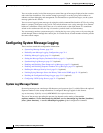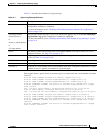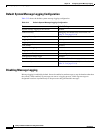
30-5
Catalyst 3750 Switch Software Configuration Guide
OL-8550-09
Chapter 30 Configuring RMON
Configuring RMON
To disable an alarm, use the no rmon alarm number global configuration command on each alarm you
configured. You cannot disable at once all the alarms that you configured. To disable an event, use the
no rmon event number global configuration command. To learn more about alarms and events and how
they interact with each other, see RFC 1757.
You can set an alarm on any MIB object. The following example configures RMON alarm number 10 by
using the rmon alarm command. The alarm monitors the MIB variable ifEntry.20.1 once every 20
seconds until the alarm is disabled and checks the change in the variable’s rise or fall. If the ifEntry.20.1
value shows a MIB counter increase of 15 or more, such as from 100000 to 100015, the alarm is
triggered. The alarm in turn triggers event number 1, which is configured with the rmon event
command. Possible events can include a log entry or an SNMP trap. If the ifEntry.20.1 value changes
by 0, the alarm is reset and can be triggered again.
Switch(config)# rmon alarm 10 ifEntry.20.1 20 delta rising-threshold 15 1
falling-threshold 0 owner jjohnson
The following example creates RMON event number 1 by using the rmon event command. The event is
defined as High ifOutErrors and generates a log entry when the event is triggered by the alarm. The user
jjones owns the row that is created in the event table by this command. This example also generates an
SNMP trap when the event is triggered.
Switch(config)# rmon event 1 log trap eventtrap description "High ifOutErrors" owner
jjones
Collecting Group History Statistics on an Interface
You must first configure RMON alarms and events to display collection information.
Beginning in privileged EXEC mode, follow these steps to collect group history statistics on an interface.
This procedure is optional.
Command Purpose
Step 1
configure terminal Enter global configuration mode.
Step 2
interface interface-id Specify the interface on which to collect history, and enter
interface configuration mode.
Step 3
rmon collection history index
[buckets bucket-number] [interval seconds]
[owner ownername]
Enable history collection for the specified number of buckets and
time period.
• For index, identify the RMON group of statistics The range
is 1 to 65535.
• (Optional) For buckets bucket-number, specify the
maximum number of buckets desired for the RMON
collection history group of statistics. The range is 1 to
65535. The default is 50 buckets.
• (Optional) For interval seconds, specify the number of
seconds in each polling cycle. The range is 1 to 3600. The
default is 1800 seconds.
• (Optional) For owner ownername, enter the name of the
owner of the RMON group of statistics.
Step 4
end Return to privileged EXEC mode.
Step 5
show running-config Verify your entries.



